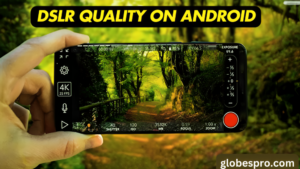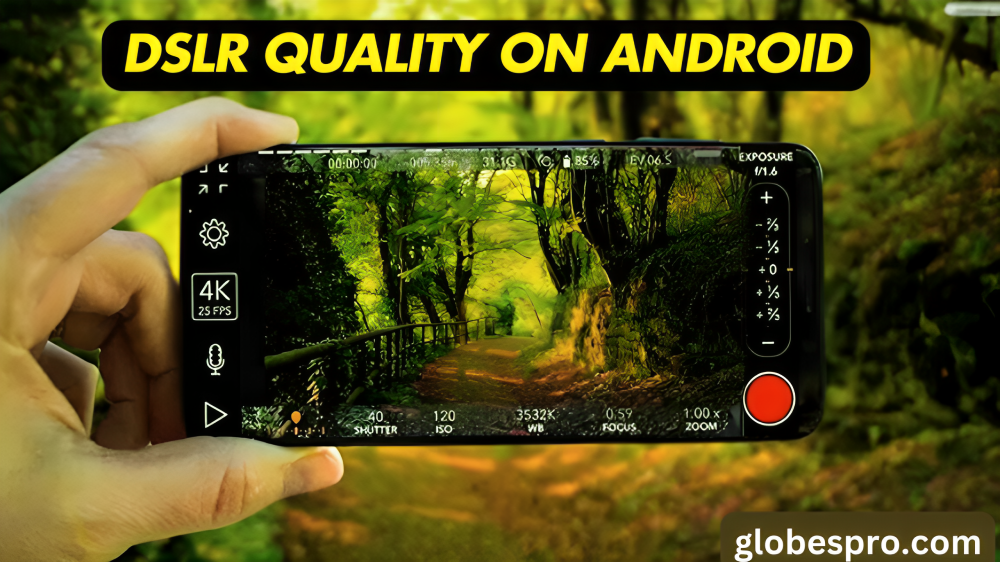Get DSLR Camera Result On Phone- Photographs of professional quality may now be taken without a heavy DSLR camera. With the development of smartphone technology, Android devices have emerged as a potent photographic tool. But can a DSLR camera really be matched by an Android phone? Even if there are some fundamental differences, you may get DSLR camera results with Android photography by combining software, accessories, and ability.
For Android, why aim for DSLR camera results?
Sharp, colorful, and detailed photos are what DSLR cameras are known for. They provide more flexibility with regard to ISO, shutter speed, and aperture. On the other hand, casual photographers or those who would like travel light may find it cumbersome to do so.
Android devices, however, are small, lightweight, and ubiquitous. With the sophisticated lenses and AI-powered software found in modern Android handsets, it’s now simpler than ever to replicate the appearance of DSLR images without spending a lot of money or time.
Knowing the Distinction Between DSLR and Android Cameras
Despite the growing sophistication of Android cameras, there are still key distinctions:
Larger sensors used in DSLR cameras provide greater light capture and crisper details.
Lens Versatility The majority of Android phones have fixed lenses or many built-in lenses, but DSLRs have interchangeable lenses for different viewpoints.
Manual Control: Manual control over settings is a feature that DSLRs excel at. With manual options, several Android applications now fill this void.
Depth of Field: Androids mimic DSLRs’ natural bokeh (creamy, blurred backgrounds) with computational photography.
Methods for Getting DSLR-Quality on Android
1. Switch between Pro and Manual Mode.
Most Android smartphones come with a “Pro” or “Manual” mode. You may adjust important settings using this tool, including:
ISO: To get balanced images, adjust the sensitivity to light.
Adjust the shutter speed to freeze or capture motion blur.
For bokeh effects, certain Androids mimic wide apertures.
Gaining proficiency in manually adjusting these parameters may significantly enhance your photography.
2. Set up apps for professional cameras.
Try using third-party applications that are designed to improve camera capabilities if you believe that your built-in camera app is lacking enough functionality. Manual controls and RAW photography are made possible by apps such as Adobe Lightroom, ProShot, and Open Camera. Because RAW files save more picture data, editing is simpler and more efficient.
3. Make use of HDR mode
The ability to capture situations with strong contrast using HDR (strong Dynamic Range) is invaluable. It keeps a picture from being overexposed or underexposed by balancing its brightest and darkest areas. Almost all Android devices come with an HDR feature.
4. Get Lenses for Your Smartphone
Your photographic options may be increased by Android device-attachable lenses, such as telephoto, wide-angle, or macro lenses. With the use of premium smartphone lenses from companies like Moment and Apexel, your photos may approach DSLR quality.

Suggestions for Improving Android Photography
Make Your Lighting Perfect
Light from the sun is your greatest ally. If you want soft, pleasing light, shoot in the early morning or late afternoon, when the light is at its best. Stay out of the direct noon sun unless you want to create striking shadows.
Keep Your Camera Stable
Images that are blurry might spoil a great photo. When you need to use longer shutter speeds in low light, use a tripod or stabilizer to keep your phone stable.
Post-Processing Is Crucial
The use of editing applications is revolutionary. With apps like Snapseed, VSCO, or Lightroom Mobile, you can imitate DSLR effects, tweak color tones, and fine-tune details. Your photographs may seem more polished and professional with features like vignette and selective focus.
To adjust depth of field, use portrait mode.
In order to replicate bokeh, the majority of Android smartphones now include a portrait mode that blurs the backdrop while maintaining focus on the subject. Apps such as After Focus provide sophisticated choices for more control.
The Greatest Android Camera Devices-Much like photography
If you’re serious about getting DSLR-quality photos, having the correct gear is helpful. Among the Android smartphones with outstanding camera systems are:
Well-known for its computational photography and superior low-light capabilities is the Google Pixel Series.
The Samsung Galaxy S Series has a 100x Space Zoom and sophisticated multi-lens configurations.
The Xiaomi Mi Ultra Series has Leica-enhanced optics and big sensors.
With controls akin to those of a DSLR, the Sony Xperia Pro is designed for photographers.
The limitations of Android cameras
Android cameras are not as powerful as DSLRs, but they do have some limitations:
depth-of-field limitation without computational assistance.
struggles under settings of severe low light.
Fewer options for nature or sports photos.
But with a little imagination and the right equipment, these restrictions may be reduced for amateur or even semi-professional photography.
Does an Android DSLR Camera Make Sense?
Certainly, Although professional DSLRs may not be entirely replaced by Android cameras, their quality is more than enough for blogs, social networking, and even small-scale projects. Knowing your device’s capabilities and pushing them to their maximum is crucial.
